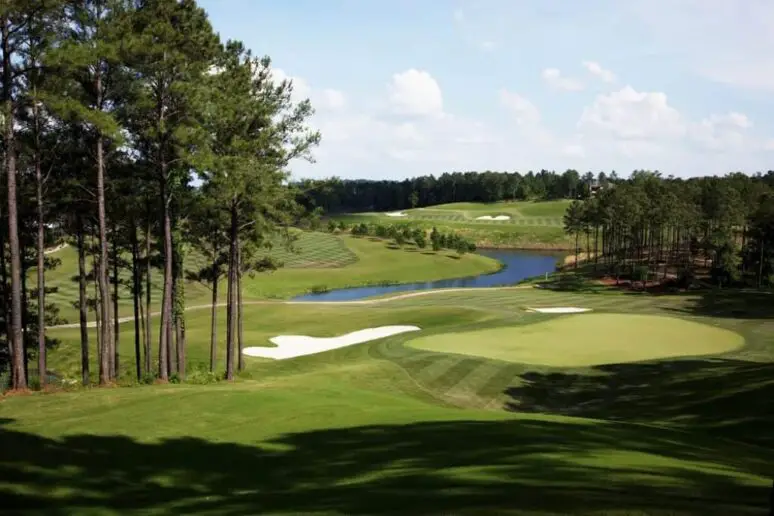How Long Does It Take to Build a Golf Course? (Solved!)
Even though it has a long history as one of the most popular sports, golf has never been as widespread as it is right now.
Only in the United States, more than 25 million people play golf on regular bases.
It probably has a lot to do with how accessible the sport has become, as new golf courses seem to appear every day.
With so many active players, many people think that building a golf course is a great investment.
However, while this may not be a bad idea, building a golf course is anything but easy.
It requires a significant investment, plenty of hard work, and takes plenty of time.
Below, I’ll look into how long does it take to build a golf course and explore all the factors that impact the timetable of such a project.
So, let’s dive in!
Table of Contents
How Long Does It Take to Build a Golf Course?
There’s no universal answer to the question of how long does it take to build a golf course.
This is because the period needed to complete the course and open it to the public can vary greatly, depending on numerous factors.
The location and the characteristics of the site are the main things that will determine the project duration.
However, other factors play a role too, including the available budget, local and state regulations, planned amenities, etc.
In general, the construction of the golf course, from breaking ground to completion, should take 1 to 2 years.
However, you have to account for all the work and procedures that happen before the construction starts.
This includes land acquisition, obtaining necessary permits and approvals, and designing the course. This part of the process also takes 1-2 years.
So, all things considered, building a golf course commonly takes between 2 and 4 years.
Key Factors Impacting the Build Timeline of the Golf Course

I already mentioned that the crucial factors that determine the timetable for the completion of the entire project of building a golf course are the location and the characteristics of the planned site.
Location
The location of the future golf site is probably the crucial variable that will determine how long will the entire building process last.
First of all, the chosen location dictates what kinds of permits and approvals you will need to build a chosen golf course.
If the location is in a zone with strict building regulations, this stage can take even up to two years.
It’s also important in what climate zone you will be building the golf course.
Obviously, in areas with a colder climate, such as the northern part of the United States, the construction itself will take longer due to more adverse weather conditions.
Plus, you’ll have a smaller time window in which you will be able to work due to cold and snowy winters.
As you move south, where the weather is warmer with more sunny days, the time needed for building a golf course shortens.
Characteristics of the Site
The amount of work needed for building a golf course will, to a large degree, be determined by the natural characteristics of the chosen site.
Generally, the more adjustments needed to the original state of the site, the longer the project will last.
Most importantly, the construction of a golf course on flat land will move much faster than on mountainous or hilly terrain.
At some sites, a lot of time and effort will be spent on tree removal and cleaning the terrain.
Then, there’s a question of water surfaces, as both the planned number of water features, such as streams and ponds, and the existing bodies of water on the location contribute to the overall build timetable.
This also impacts the number of drainage structures that need to be installed. Finally, the type of soil also matters, as some types are easier to build on than others.
How Much Land is Needed for a Golf Course?
How much land you’ll need for a golf course will, for the most part, depend on what type of course you want to build.
There is a wide range of different golf courses, from small putting courses where families can have some fun, to championship courses where the best golfers in the world compete on the Pro Tour.
It’s all about skilled design and fitting what you want to the label amount of land.
For example, a 400-yards par 4 hole will commonly occupy around 10 acres. However, that land can also fit three or four par 3s, with 6 to 150 lengths.
So, it’s up to the designer and the investor’s intentions to arrange the course across the acquired land.
Championship Courses
The championship course is, naturally, the most challenging, with the greatest distance between holes.
An 18-hole, par 72 golf course can take up anywhere from 150 to 200 acres of land, depending on the design and the site characteristics.
Standard Courses
The standard golf course, designed mainly for amateur play, also features 18 holes, but there’s less distance between them.
This type of course commonly occupies about 135 – 165 acres.
Executive Courses
The executive course usually features 18 holes of par 3s and par 4s, with the average par in the low 60s.
This means that to build this type of course, you’ll need between 75 and 110 acres.
Executive courses can also feature 9 holes which require about half of the land of the standard course, 40-45 acres.
Pitch and Putt Courses
Pitch and Putt courses usually feature 9 holes and usually take up around 15-20 acres of land, although they can be built on also little as 10 acres.
The smallest Putt course, mainly designed for families with kids, requires the least amount of land and can be built on just 0.5 acres.
Steps in the Process of Building a Golf Course

Once the golf course design is finished and the investors have all the required permits, the construction phase which will last for 1-2 years can start,
The building process includes several stages, and carefully planning each of them help build the course in a shorter period of time. Below are the main steps in this process.
Preparation
Before the construction workers can get to shaping the golf course and giving it its final look, there’s plenty of preparation work to be done.
The grading comes first. As no one wants to play golf on flat land, the grading process involves the use of heavy machinery to add hills and mounds to the course to make it more interesting.
Grading can also include removing and clearing landmarks from the course.
After the grading is done, the drainage system is added to the golf course. Draining is necessary, so the course doesn’t get flooded.
Flooding not only ruins the course but also causes the development of fungus in the turf. In addition to drainage, the course also needs irrigation.
The irrigation system will ensure that the grass is healthy and the course is playable thought the year, even during the scorching summer days.
Shaping the Course
The length of a shaping process depends on the complexity of the course design, the location, and how difficult the land is to work on.
It starts with determining where the rough and fairways will be. The lines along the rough/fairway divide have the most impact on the final outlook of the course.
Installing the green is next.
This is a rather complex process and involves a lot of math to get the slopes and angles of the green right, so the ball will roll as the designer envisioned it.
This stage involves a lot of testing and adjusting until the greens are just right.
Once the greens are done, the building crew moves on to installing the tees which is probably the easiest part of the course-shaping process.
Still, tee boxes need to be the right height, with enough room to move around, and face the proper direction.
Add-on Features
The additional features are often what makes a certain golf course stand out among the others, so it’s important to get this right.
These distinguishing features commonly include water features, bunkers, and car paths and bridges.
The designers and investors have a lot of freedom when it comes to choosing which of these features the course will have, but they have to be aware that it may make or break the entire golf course.
Some of these features are natural and already exist on the land, such as lakes, while the others have to be additionally designed and constructed.
Conclusion
Building a golf course is one of the most complex endeavors an investor can undertake. It’s fairly expensive and takes plenty of time to finish.
Depending on what type of golf course is planned, the construction itself will likely take at least a year.
This is not counting all the work on obtaining various permits and designing the course.
Still, it’s always better to take time and pay attention to every detail of the golf course, as that’s the only way to ensure that those who the course is intended for, the golfers, will truly enjoy it and keep coming back.




